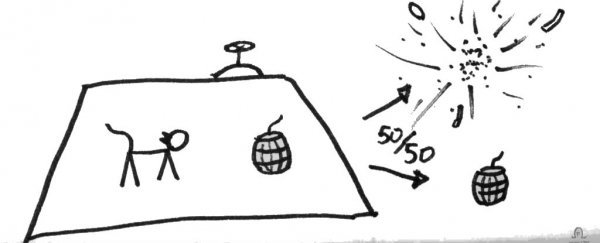
Studying quantum physics is a bit like trying to interpret Shakespeare's Hamlet - if suddenly everything makes sense, and you think you've finally got a handle on it, you probably understand less than the guy sitting next to you with his head in his hands.
But despite certain concepts in physics being inherently unfathomable, there's always room to get a better grip on the basics. You might think you know the story of Schrödinger's cat from the inside-out, but could you explain it to your 10-year-old nephew in a way that he actually understands?
If your answer is no, or "Wait, is that the cat that can't decide if it wants a beer or not?" this MinutePhysics video is for you.
At its most basic, the thought experiment dreamt up by Austrian physicist Erwin Schrödinger in 1935 goes like this: you put a cat in a box with some live explosives that have a 50/50 chance of exploding once you close the lid. For our purposes, this is a magical, explosion-proof box that betrays no signs of what's actually happened on the inside.
That last point is key - the deal is that the fate of the cat is unknown to you until you open up the box. So in other words, until you open the box, the cat occupies two states simultaneously - dead or alive.
Sounds simple, right? Nope, start again, you just did the Hamlet thing. What's tricky about this hypothetical scenario is that for as long as we keep that box lid closed, the cat is in what's known as a superposition state - it's both dead and alive, because it has to be one, and it can't be neither.
Once we open the box, "Our act of looking forces nature's decision," says Henry in the video above. "So our curiosity kills the cat."
But wait a minute, I hear you say, us looking in the box can't change the reality of what's already happened in the box - nature has already made that decision. Exactly - the above is only from our perspective, but what about the cat's perspective?
As the video explains, because the cat can actually see what's happening inside the box, its experience is entangled with the outcome of the experiment, and it's our observation of the experiment that causes nature to 'collapse' into one option or the other. The reality might be that there is only one real option, but until we observe that reality, the two options stand.
This kind of thinking has big implications for our place in the Universe.
Why? Well, if you take a step back from the scenario that has you looking at a box with an alive cat inside and a box with a dead cat inside, and think about the perspective of someone looking at you looking at a box, things become a whole lot more complicated. If you looking inside the box collapses the two possibilities into one reality, who's looking at you to make your act of box-opening a reality?
No, we're not talking about God, but this is one of the biggest, most confounding questions in physics, and one explanation could be that there are there are infinite parallel universes that cater to every possible option for every possible scenario.
Watch the MinutePhysics video above to see all of this explained to you in less than 2 minutes, and once you're done, wrap your head around a similar conundrum - if the Universe is expanding, what's it expanding into?

